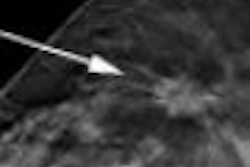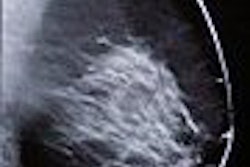The U.S. Food and Drug Administration (FDA) is proposing changes to the way it regulates full-field digital mammography (FFDM) systems. The move should make it easier and less costly for mammography vendors to bring FFDM systems to market when the new rules are scheduled to go into effect in 2009.
The FDA issued a proposal in the May 30 Federal Register that would reclassify FFDM systems from the current class III category, which requires premarket approval (PMA) applications, to class II, which requires the less rigorous 510(k) process. The reclassification would eliminate or reduce the requirement for vendors to conduct large-scale multireader, multicase (MRMC) clinical trials prior to submitting applications for equipment approval. Public comment and suggestions on the new proposed requirements will be accepted through August 29.
The move comes as FFDM systems are rapidly replacing analog units. Some 92% of the 1,776 mammography systems sold in the U.S. in 2007 were digital, according to data from the National Electrical Manufacturers Association (NEMA) of Rosslyn, VA. By comparison, digital mammography systems represented 61% of sales in 2006.
Statistics gathered under the Mammography Quality Standards Act (MQSA) for May 2008 reveal that 37% of facilities performing mammography procedures (3,264 of 8,869) had at least one digital system installed. In a 12-month period, there has been an increase of 16.6% in FFDM's market penetration.
If the proposal is adopted, the FDA will rely upon well-designed bench studies and limited clinical testing in lieu of large-scale MRMC clinical studies. Products using new technology, with dissimilar designs from approved systems, or having indications for use that are dissimilar from legally marketed devices of the same type, may be required to collect additional clinical data.
An MRMC study may be required to compare sensitivity, specificity, and receiver operating characteristic curves if the results of physical laboratory testing and mammographic feature analysis raise concerns by the FDA.
Vendors approve
Vendors interviewed by AuntMinnie.com believe that the expensive and onerous mandatory requirement to conduct large-scale clinical trials will not be imposed on the majority of FFDM product applications under the 510(k) process.
"We support the declassification," said David Caumartin, global general manager of the mammography business at GE Healthcare of Chalfont St. Giles, U.K. "FFDM in our mind is now a mature technology in which MQSA and daily quality control procedures enable greater healthcare benefit and a controlled risk and effectiveness to asymptomatic patients. We think it will enable faster innovation in FFDM for a broader number of patients as a whole."
That sentiment was echoed by Dr. Phil Macarthy, regulatory, quality systems, and clinical affairs director of Carestream Health of Rochester, NY. Macarthy had a lengthy career as a senior scientist at the FDA before joining Carestream and its predecessor company, Eastman Kodak.
"With a 510(k) reclassification, the go-to-market timeline has the potential to be significantly reduced," he said. "In addition to the time spent conducting a large-scale clinical trial, the application time for a PMA is 180 days. If the FDA reviews and rejects the validity of the clinical trial, it is necessary to repeat the study, resubmit the application, and wait another 180 days. A properly documented 510(k), even with special control requirements, may expedite the process to 90 days."
The FDA's decision to reclassify FFDM modalities was actually made two years ago, according to Fujifilm Medical Systems USA of Stamford, CT. "Many vendors in the industry have been expecting this announcement, and we believe that there is ample experience with FFDM to warrant the change," said Andrew Vandergrift, national marketing manager of Fuji's women's healthcare imaging services. "In the case of Fuji CR for Mammography [FCRm] in particular, the technology has been used around the world for FFDM since its introduction in 1983."
Fuji also believes that the change will enable new FFDM products, as well as enhancements to existing products, to enter the market faster, ultimately to the benefit of healthcare facilities and their patients. Vandergrift also expressed hope that with the introduction of the draft guidance document, the FDA will streamline the current regulatory process for computer-aided detection (CAD) software, which has inhibited the approval of CAD for use with FFDM.
One mammography vendor, Planmed of Helsinki, Finland, submitted an application for its FFDM product to the FDA on June 30, 2006, and is still awaiting approval. Chris Oldham, director of North American sales at the company, expressed optimism that the proposed change to class II might expedite FDA approval.
"Planmed will continue with its clinical trials unless otherwise notified by the FDA," he said. "However, our FFDM is used throughout Europe and received approval this year for its sale in Canada, and we are anxious to receive approval to sell in the U.S. market."
Carestream's Macarthy believes that the availability of a greater choice of computed radiography (CR) and digital radiography (DR) mammography systems will accelerate acquisition by mammography centers, and in so doing, improve public health.
GE's Caumartin, meanwhile, does not feel that the change will detract from the sales of flat-panel digital radiography-based mammography systems. "Europe, for instance, had an initial fast and large CR adoption and then saw CR mammography numbers decreasing in adoption versus DR because of DR's higher efficiency in workflow and stereo capability, and high cost of archiving," he said.
By Cynthia Keen
AuntMinnie.com staff writer
June 10, 2008
Related Reading
FFDM reimbursement: Money still matters, May 23, 2008
Making dollars and sense out of Medicaid and FFDM reimbursement, December 20, 2007
FFDM makes headway as primary breast cancer screening modality, November 27, 2007
Walking the tightrope: The legal and regulatory impact of digital mammography, October 11, 2007
Positioning is the key to making the most of FFDM, October 10, 2007
Copyright © 2008 AuntMinnie.com



















